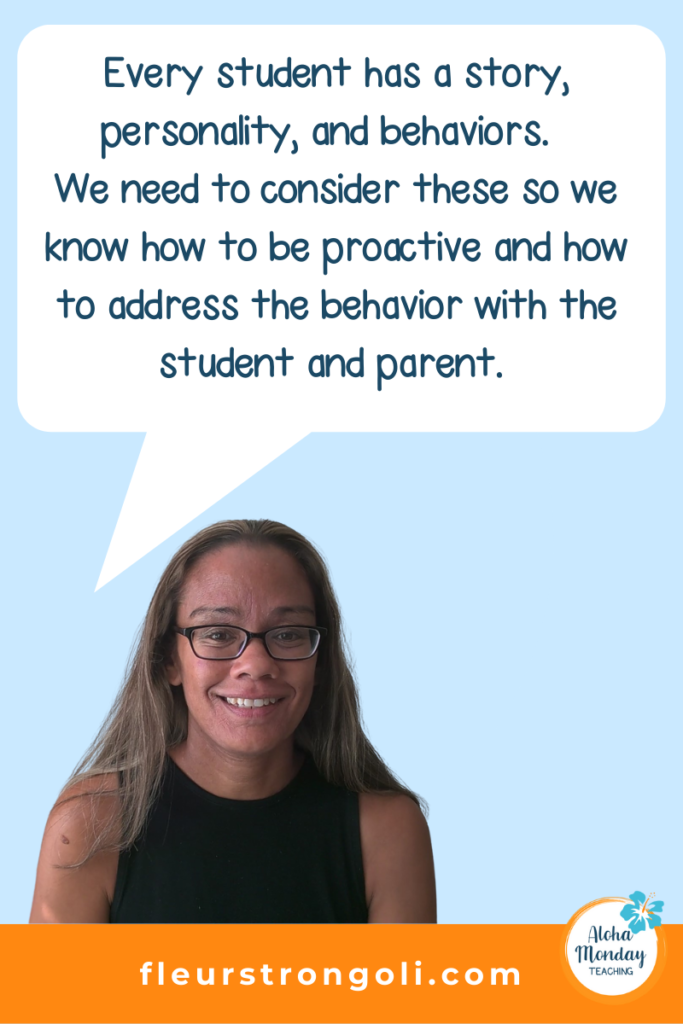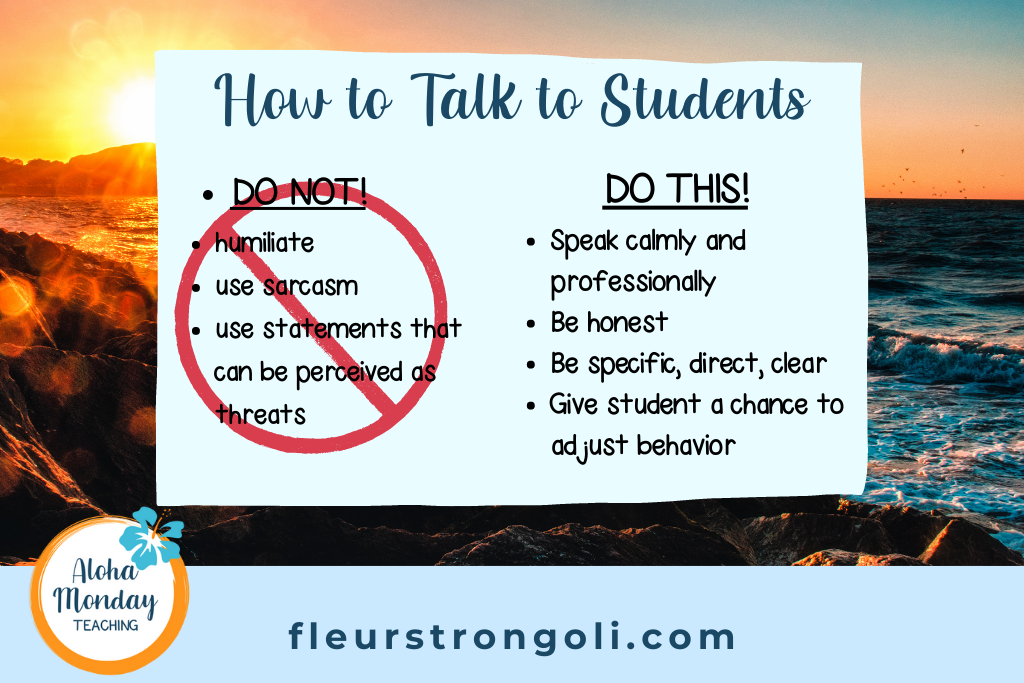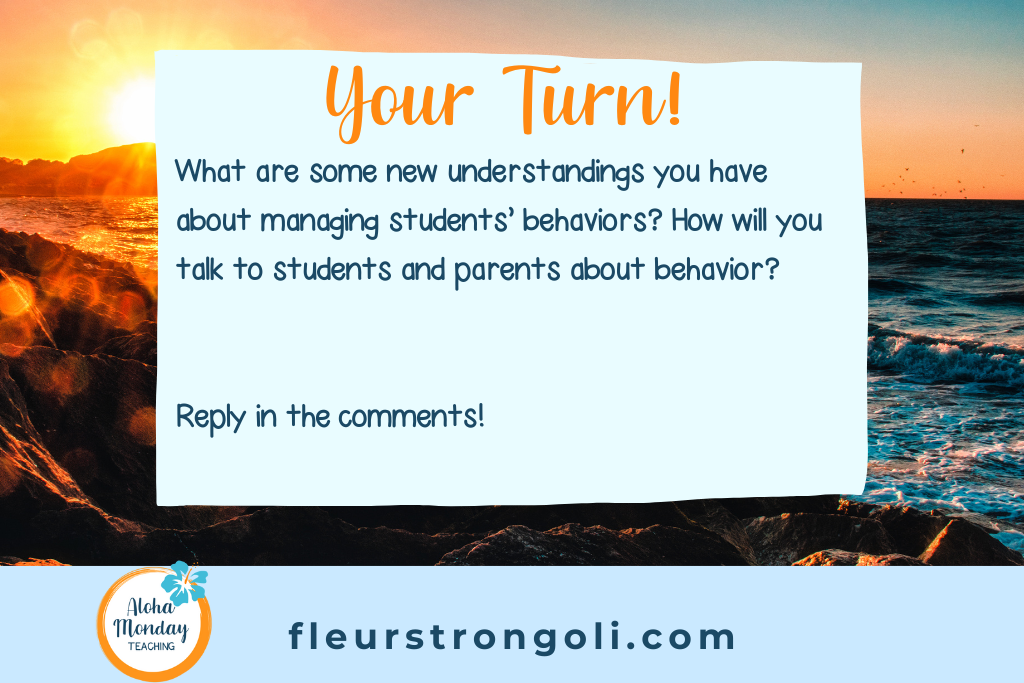How Do Teachers Manage Student Behavior with a Student’s Dignity in Mind?
It’s rare that we get to see our fellow teachers in their classrooms, so do you ever ask yourself, “How do teachers manage student behavior in their classroom?” There are several different management styles, and teachers have their own personalities. But the thing to remember is no matter how you manage your classroom, it’s important to keep your student’s dignity in mind. So how do teachers manage student behavior while considering their student’s dignity?
In This Post
We will discuss some student behaviors we see and what might cause them. Then we’ll discuss managing student behavior in the classroom. Talking to students while keeping their dignity is extremely important. We will go over how to talk to students about their behavior so they are held accountable and they can work on changing the behavior. Finally we will go over how to talk to parents about student behavior.
Disclosure: This post contains some affiliate links for your convenience. As an Amazon Associate I earn from qualifying purchases with no cost to you.
What are Some Student Behaviors in the Classroom
Every student we teach has a story, and every student has their own personality. It can make for some very challenging classes. What are some behaviors in the classroom?
Some minor behaviors include being off task, daydreaming, not completing work, talking, wandering, being unorganized, or being unprepared.
Other behaviors that are more bothersome or more serious include talking back, constant talking, disruptive behaviors, defiance, inappropriate behaviors or comments, arguing, fighting, throwing things, or getting angry and swearing.
Each behavior tells a bit about the student. What is their story, what are their needs? We need to consider these so we know how to be proactive and how to address the behavior with the student and parent.
Some possible causes of misbehavior include being academically low, having a learning disability, having an emotional disability, trauma, not enough sleep, home life, busy parents, not enough attention, boredom, uninterested in topic, or not feeling respected or accepted by peers or the teacher.

Managing Student Behavior
Knowing some possible reasons why students behave the way they do will help teachers manage student behavior. Knowing about brain development in adolescents will also help you manage behaviors.
Our brain’s main function is to keep us alive. One way it does this is by triggering the amygdala when there is a possible threat.
The amygdala is a tiny structure in the brain that causes us to feel stress and makes us react with fight, flight, or freeze.
The middle schooler’s amygdala is very reactive! Students have a harder time controlling this, since their brains are still developing and they are learning skills. We have (for the most part) learned how to cope and deal with stressful situations and can calm our amygdala down…sometimes.
A student’s amygdala can get “hijacked” (term used in the book Culturally Responsive Teaching and the Brain– a must read), very easily. A student can look at them funny (even if they’re not even looking at them), someone can say something that offends them, or there is a test coming up. Once their amygdala has been hijacked, they may need to help them calm down.
A very effective way to calm the amygdala is through breathing deep breaths. Here is a great video that helps students understand this and calm down.
And when it comes to managing a student’s behavior, I like to use strategies from Teaching with Love and Logic. One of my favorite ways is to focus on a student and notice things about them. You use the words “I noticed” and something simple. “I notice you’re wearing blue. That’s my favorite color.” “I noticed you put a lot of effort into your work today.” These will lift up your student and it will make behavior change and a positive relationship more possible.

How to Talk to a Student About Their Behavior
Learning how to talk to a student about their behavior and staying calm is a skill most teachers have to develop. We learn from experience- whether it was the way our parents and adults in our lives talked to us or what we learn after teaching for several years. If you’re still learning this skill, talk to the veteran teachers at your school. They should be able to share specific examples of how they talk to kids.
First, let’s talk about what NOT to do. Do not humiliate them in front of the class. Don’t say empty threats. Don’t be sarcastic.
When you talk to a student, it is best to talk privately. Tell them to go into the hallway. Then you can talk privately with the student. Or you can kneel next to the student’s desk and talk privately there.
When you are talking to a student, ask them a question so they can talk about their behavior. Examples include, “Why do you think I want to talk to you?’ “Why did I ask you to go to the hall?” “Tell me about your behavior choices.” “Is there anything you want to tell me?”
Let the student express themselves first. Model listening by actually listening to the student. This will help them feel cared for and respected.
Then, calmly tell them what you observed about their behavior. Be honest and direct- do not beat around the bush. Make sure you are talking about their behavior, not them as a person. You can read some great examples of specific language when talking to students in the book “The Power of Our Words”.
Then give them an opportunity to adjust their behavior. “Can you control your talking?” “Will you be able to fix the behavior in class”
Doing this will give the student a chance to adjust, which may be all that is needed. If they can’t, then it’s time to resort to other consequences like moving their seat or having them leave the room. These are important when teachers manage student behavior.

How to Talk to Parents About Student Behavior
Talking to parents is another skill that most teachers have to develop. Before ever talking to parents about their child’s behavior, you must first build a relationship with them. This starts at your Meet the Teacher or Open House night. Be sure parents know that you are a team and want the best for their child.
Then send regular emails home in a newsletter so they are used to hearing from you and know what’s going on in class.
Just doing those two things will build trust with the families of your students. So when you have to talk about behavior, they are open to listening and supporting you in class.
So what do you say to parents? You can email or call. There are times I prefer to call parents because there is just too much to say in an email. But most of the time I email home and parents respond quickly with support.
Just like with students, you need to be calm, honest, and direct. With parents, you will state why you are contacting them, and explain what happened. Then ask them if there is anything else you can do at school to support their child. Finally thank them for their support.
If you need to check for your tone and to make sure there is nothing emotional or accusatory in your message, be sure to ask a fellow teacher to read your email before you send. You do not want to send a message that puts the parent on the defense. Remember, you are a team.
When you do this, you are letting parents know that you care about their child, you want the best for their child, and you appreciate the support from the parent.
And when you have the parent’s support, you will likely see a change, temporary or permanent, in behavior in the classroom.

Wrap Up
We talked about different types of behaviors we see in our classrooms as well as possible reasons for these behaviors. Understanding possible reasons why they behave this way and by understanding the adolescent brain will help us with being proactive to manage behaviors. We also know it is important to keep a student’s dignity, so I shared ways to talk to students about behavior. And when talking to parents about their child’s behavior, we want them to know we care about their child, want the best for them, and appreciate their support.
Your Turn
What are some new understandings you have about managing students’ behaviors? How will you talk to students and parents about behavior?

Read More
The Power of Our Words from the Responsive Classroom
Culturally Responsive Teaching and the Brain
I Need Help Managing a Talkative Classroom! What Should I Do?
YouTube video – be sure to subscribe!







